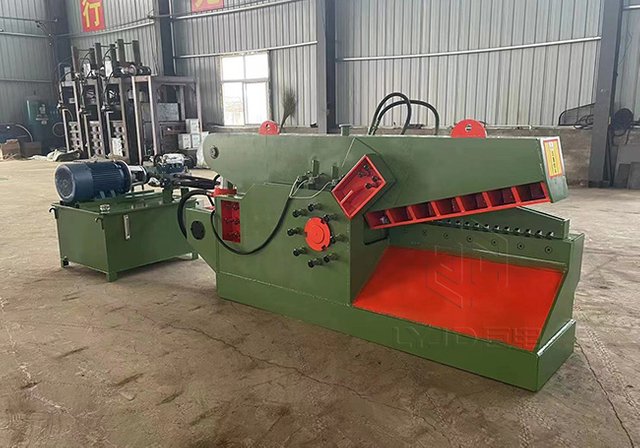Function and Classification of Flying Shear in Small Steel Rolling Production Line
Flying shears are used for transversely shearing moving rolling pieces, which are called flying shears. With the development of continuous steel plate rolling mills, section steel rolling mills and billet rolling mills and the improvement of flying shear productivity, the application of flying shears is also increasing. more extensive. There are many types of flying shears, and the most widely used ones are: disc flying shears, double-drum flying shears, crank rotary and pendulum flying shears, etc.

Disc type flying shear - this type of flying shear is generally used in small rolling mill workshops. It is installed in front of the cooling bed to roughly cut the rolled piece so that the rolled piece entering the cooling bed will not be too long; or it is installed in front of the finishing rolling unit to cut the head of the rolled piece to ensure the rolling process of the finishing rolling unit went well. Flying shears consist of two or more pairs of disc-shaped blades whose axis is equal to the speed of the steel. When the flying shear is in the original position, the steel advances along the inlet duct to the left of the flying shear. When the steel acts on the flag-shaped switch or the light pipe, the inlet pipe and the steel are deflected to the right, and the steel enters the middle of the two discs for shearing. After the lower blade is lowered, the guide tube returns the steel to its original left position, after which the lower blade rises again. The disadvantage of this type of flying shear is that the incision is oblique, but it has little effect on the cutting head or the rough shearing of the rolled piece before the cooling bed. Because this kind of shearing machine is reliable in operation, simple in structure, and the shearing speed can reach more than 10m/s, it is widely used in small rolling mill workshops.
Double-drum flying shears—Double-drum flying shears are widely used to cut steel and steel plates in motion. Its working principle is as follows: On two rotating drums, two blades are fixed radially. The rolling piece moving along the roller table is cut by the two blades when it passes through the middle of the two rollers. The peripheral speed of the blade should be slightly greater than the moving speed of the rolled piece, otherwise the rolled piece will be bent at the entrance during shearing. The disadvantage of this kind of flying shear is that the cross-section is uneven when shearing thick rolled pieces (it has a great influence on shearing thin-faced rolled pieces); when shearing wide steel plates, the shearing force is relatively large. Therefore, this flying shear is used for shearing small sections and thin plates of high-speed rolled pieces.
Crank rotary flying shears - its shearing mechanism consists of a four-bar linkage mechanism, and the shearing blade moves approximately in a plane in the shearing area and is perpendicular to the surface of the rolled piece. Therefore, the cut section of the rolled piece is relatively straight. The cutting mechanism of the flying shear is composed of a knife holder, an eccentric sleeve and a swing rod. The knife rest is made into a lever shape, one end of which is fixed on the eccentric sleeve, and the other end is connected with the swing rod, and the swing fulcrum of the swing rod is hinged on the column. When the eccentric sleeve (crank) rotates, the tool holder moves in translation, and the blade fixed on the tool holder can be perpendicular or nearly perpendicular to the rolled piece. When cutting the steel plate, the inclined blade can be used to reduce the shearing force. The disadvantage of this kind of flying shear is that the structure is complex, the dynamic load characteristics of the shearing mechanism are poor, and the moving speed of the blade cannot be too fast. It is generally used for shearing thicker steel plates or billets.
Pendulum Flying Shear - This type of flying shear is sometimes used in the cross-cutting unit of the continuous steel rolling mill shop. The blade of this flying shear also moves in translation, and the quality of the sheared plate is better. The upper knife rest is fixed on the swing frame. The swing frame is supported eccentrically on the main shaft. There are two pairs of eccentrics on the main shaft, and the other pair of eccentrics is connected with the lower knife rest through the connecting rod, and the lower knife rest can slide in the chute of the swing frame. Because the two pairs of eccentric positions on the main shaft differ by 180°, when the main shaft rotates, the upper knife rest goes down with the machine frame, while the lower knife rest rises to complete the shearing action. However, it can only cut stationary rolling stock. In order to be able to shear the moving rolled piece, it is necessary to make the swing frame swing back and forth. The lower part of the swing frame is hingedly connected with an eccentric rod, and the eccentric wheel is mounted on the rear axle. The rear axle is connected to the main shaft via a pinion, rack and synchronizing disc. When the main shaft rotates, the rack can swing reciprocatingly around the main shaft through the synchronous disk, rack, pinion and eccentric connecting rod on the rear axle. cut work.
Although the role of the shearing machine in the rolling mill equipment is not a key position, it plays a vital role in the accuracy and shape of the finished product. Different types of rolling mills should choose corresponding flying shears, so that the entire production line can achieve The size and precision of the target.